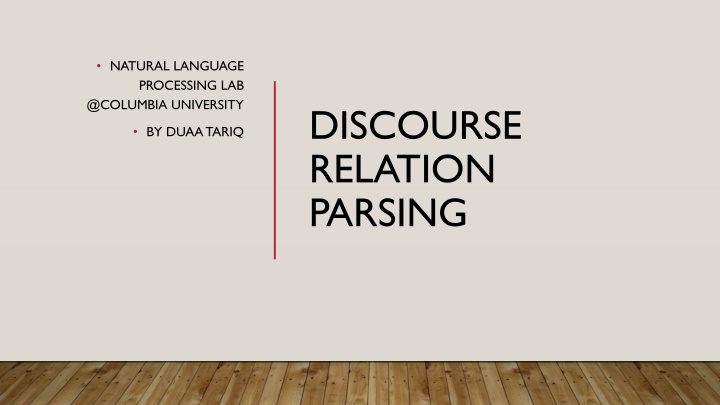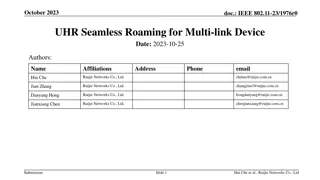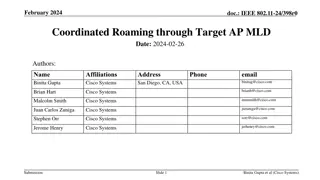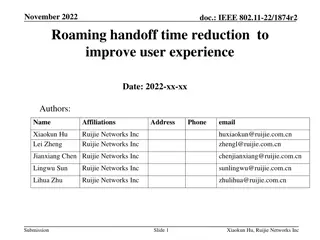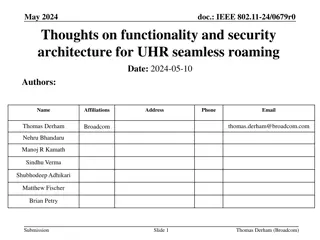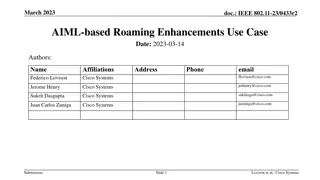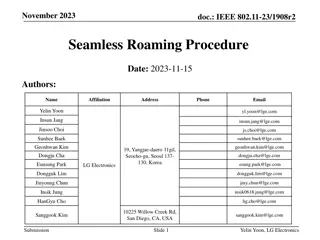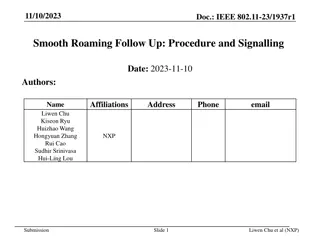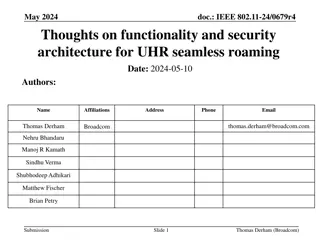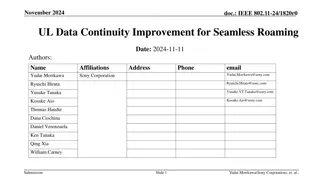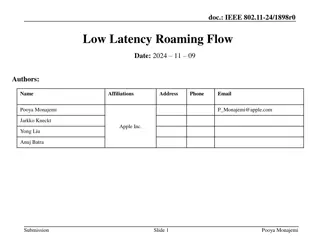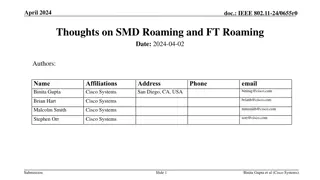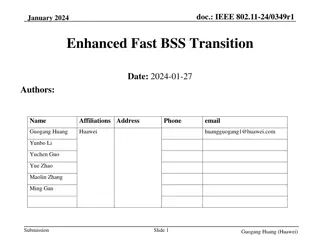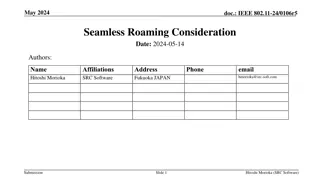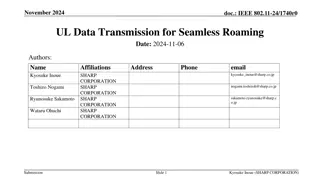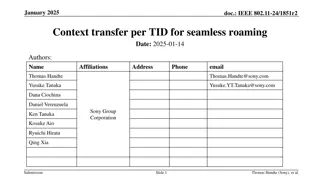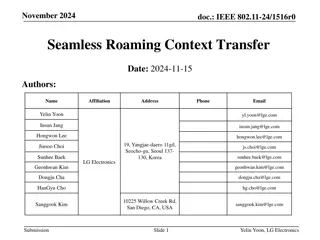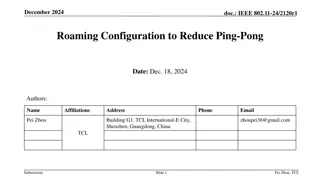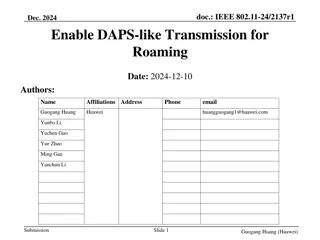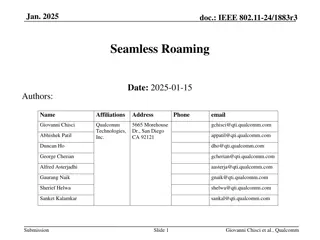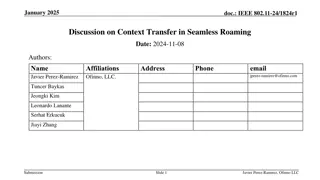IEEE 802.11-24 Seamless Roaming Context Transfer for Enhanced User Experience
This document discusses seamless roaming in wireless networks and focuses on context transfer for improved user experience. It addresses critical phases, data limitations during context transfer, and the impact of context information separation on roaming efficiency. The submissions highlight the importance of static and dynamic context information, transfer per TID, and optimizations for efficient data transfer. The goal is to enhance the overall roaming operation and user satisfaction in IEEE 802.11-24 networks.
Download Presentation

Please find below an Image/Link to download the presentation.
The content on the website is provided AS IS for your information and personal use only. It may not be sold, licensed, or shared on other websites without obtaining consent from the author.If you encounter any issues during the download, it is possible that the publisher has removed the file from their server.
You are allowed to download the files provided on this website for personal or commercial use, subject to the condition that they are used lawfully. All files are the property of their respective owners.
The content on the website is provided AS IS for your information and personal use only. It may not be sold, licensed, or shared on other websites without obtaining consent from the author.
E N D
Presentation Transcript
NATURAL LANGUAGE PROCESSING LAB @COLUMBIA UNIVERSITY DISCOURSE RELATION PARSING BY DUAATARIQ
INTRODUCTION: Background: Discourse relation parsing is a research area in Natural Language Processing focusing on analyzing discourse structures by identifying different types of discourse relations (in a spoken or written text). Previous Research: The STAC data set (Asher, 2016) is an annotated multi-party chat log for an online game. Project Goals: - Contribute a dataset consisting of discourse relations annotated for long dialogues, specifically transcripts of TV show episodes. -Apply knowledge of discourse relation recognition and link prediction to the task - Research and use tools to effectively complete annotations -Analyze frequencies of defined relation labels, identify new challenges and relation types
METHOD: Episodes- TV show episodes from the Forever Dreaming collection (Chen & Chu, 2022). Sample size will consist of 1000 episodes. More- Research tools, previous publications (ex: STAC corpus for an annotation trial) Annotate- Define the discourse relations prior to the process. Annotate the spoken dialogues in the transcript using Inception, an online web application. Revise- Revise and redefine the type of discourse relations relevant for the sample. Identify and fix any errors overseen during annotation process. Understand- Numerically record and analyze the results. Explore further steps and ideas.
INCOMING RELATIONS EDUs (elementary discourse units) are any meaningful part of an utterance or statement. Discourse relations will be incoming meaning based on previous EDUs (i-1). Relations do not have to be adjacent and can be linked to any previous EDU. i - n ,i - 3 ,i - 2 ,i - 1 --> i --> i + 1
EXAMPLE: 259 R: Isn t this amazing? 260 R: I mean, I have never made coffee before in my entire life 261 C: That is amazing. 262 J: Congratulations.
RESULTS: FREQUENCIES OF RELATIONS IN EXAMPLE EPISODE Relation Type # Narrate-Elab 7 Contrast 18 Comment Continuation Acknowledgment Question-Answer Pair Elaboration Clarification Question 68 53 49 35 Conditional 4 Explanation 17 Recount Narration 3 Q-Elab 17 Repetition 16 Correction 2 Present Narration 12 Interruption 2 24 21 Parallel 12 Total 409 Alternation 10 Rhetorical Question 10 Background 21
Number of occurrences Relation Type Relations are labelled from 1 ( comment ) to 21 ( interruption )
Observations: In long dialogues, comment , continuation and acknowledgement are the most frequent relations due to consistent conversation between characters. correction and interruption are rare occurrences in the example episode, likely due to chance. Each scene begins with comment since they are usually unrelated to previous EDUs. repetition and rhetorical question are new relations due to the added use of rhetoric in TV episodes (entertainment). repetition and acknowledgement were picked up by Inception and became predictable. ANALYSIS: Challenges: STAC has players focused on one objective, which was the game. TV episodes consists of a variety of scenarios. TV shows are multi-modal, so it is more difficult to detect sarcasm (or tone of the speaker) from just the written text The STAC corpus consisted of chat only, whereas there is a lot more action and spontaneity (resulting in interruption, etc.) on TV shows. Instances where characters speak on the phone, and you can only assume what the other person is saying. One-sided utterances are still a part of the dialogue.
FUTURE WORK Relations may still need to be redefined, multiple relations for single utterances should be explored. Friends is a limited genre, so a variety of shows and episodes are needed. Larger sample size of at least 1000 episodes.
ACKNOWLEDGEMENTS/REFERENCES Mentor: Yilun (Bobby) Hua PI: Professor Kathleen McKeown Resources: Tools- Inception: Technische Universit t Darmstadt -- Computer Science Department -- INCEpTION -- 23.8 (2022-06-29 21:24:41, build 4b271961 Forever Dreaming Transcripts: Chen, M., Chu, Z., Wiseman, S., & Gimpel, K. (2022, June 6).SummScreen: A dataset for abstractive screenplay summarization. arXiv.org. Retrieved July 28, 2022, from https://arxiv.org/abs/2104.07091 STAC data set: Asher, N., Hunter, J., Morey, M., Farah, B., & Afantenos, S. (n.d.). Discourse structure and dialogue acts in multiparty dialogue: The stac corpus. ACL Anthology. Retrieved July 28, 2022, from https://aclanthology.org/L16-1432/ Li, J., Liu, M., Qin, B., & Liu, T. (2022, January 20). A survey of discourse parsing - frontiers of computer science. SpringerLink. Retrieved July 28, 2022, from https://link.springer.com/article/10.1007/s11704-021-0500-z Shi, Z., & Huang, M. (n.d.). A deep sequential model for discourse parsing on multi-party dialogues. Proceedings of the AAAI Conference on Artificial Intelligence. Retrieved July 28, 2022, from https://ojs.aaai.org/index.php/AAAI/article/view/4680
